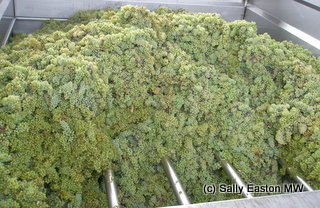Bright whites from Spain
A version of this article first appeared in Hampshire View, July 2008.
There are a couple of grape varieties indigenous to Spain that are making some fresh waves on the wine scene. These wines are so far removed from the traditional sherries, and unpalatable oxidise table wines that they deserve a song and dance made about them.

Whole bunches ready for pressing
The key thing that’s helped these traditional varieties on the world stage, is the adoption of various bits of technology that revolutionised new world winemaking thirty odd years ago. The use of stainless steel vats, controlled cool fermentation temperatures and without oxygen getting into the process, plus post-fermentation refrigeration, as well as some night harvesting to preserve the cooler, fragrant flavours in the grape, has all led to wonderfully fresh, crisp, fruit-focused wines from a couple of different areas in the north of the country. They also bear no relationship to the new, revitalised, but still oak fermented and matured, white Riojas.
Albarino and verdejo are all about crisp, dry, green apple and citrus fruit, sometimes with a richer vein of tropical fruit, and a complete absence of oak, in a refreshing style. They are the Spanish trump on sauvignon blanc, riesling and pinot grigio.
Albariño from Rias Baixas in Galicia, just above Portugal, leads the way for white wine in Spain. Positioned on the cool Atlantic, north west coast of the Iberian peninsula where the weather is damp and breezy, the area is something of a home from home for us. Here, albariño’s thick skins both protect against the humidity as well as provide the source of some of the flavours of citrus, peach and orange blossom.
Verdejo, on the other hand, does come from the interior, from Rueda in north-west Spain. But it has altitude on its side, being on the high northern meseta, so nights are cool enough to retain those all-important aroma compounds in the grape. Combine that with all the modern winemaking techniques and this naturally high acid variety offers apple blossom, white pear and white nectarine fruits. It appears as Rueda Superior. Rueda without Superior may only have 25% of verdejo in it, but the ‘Superior’ version has at least 85%. It can be blended with sauvignon blanc or viura (the main white Rioja grape variety), but to my mind and palate, the more verdejo the better.
Try these for size, either on their own, or with light seafood dishes. The Verdejo is the humbler grape variety, the albariño the more serious.
M&S: Cuatro Rayas Verdejo, Rueda, 2007. £6.49
Tesco: Finest Palestra Rueda Verdejo 2007 £5.99
Majestic: Martin Codax Albariño, Rías Baixas, 2006 £8.99 (£7.99 ea for two bottles, till July 28th)
Wine Society: Pazo Señorans Albariño, Rías Baixas, 2006 £9.95



